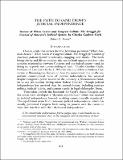|
Reseña:
|
Reseña:Despite a title that evokes the Fox Television perennial When AnimalsAttack, When Courts & Congress Collide: The Struggle for Control ofAmericas Judicial System! is scholarly, engaging, and timely. The bookbrings clarity and life to a subject that can be both opaque and dry-thecomplex relationship between Congress and the federal courts-and, indoing so, expands our understanding of each. Charles Gardner Geyh,Professor of Law and Charles L. Whistler Faculty Fellow at Indiana Universityat Bloomington, focuses on how the non-textual, but vitally important,constitutional value of judicial independence has surviveddespite Congress's power to control the judiciary, a phenomenon familiarto any law student having taken Federal Courts.? Though judicialindependence has survived thus far, several threats, including partisanpolitics, judicial hubris, and current trends in legal philosophy, loom.These ideas provide the bookends for Geyh's thesis: Congress andthe courts have developed a dynamic equilibrium, which has resultedin judicial independence beyond anything constitutionally rnandated.The equilibrium stems from customary judicial independence, which hasusually prevented Congress from using its powers over the courts inways that interfere with their decisional independenceDespite a title that evokes the Fox Television perennial When AnimalsAttack, When Courts & Congress Collide: The Struggle for Control ofAmericas Judicial System is scholarly, engaging, and timely. The bookbrings clarity and life to a subject that can be both opaque and dry-thecomplex relationship between Congress and the federal courts-and, indoing so, expands our understanding of each. Charles Gardner Geyh,Professor of Law and Charles L. Whistler Faculty Fellow at Indiana Universityat Bloomington, focuses on how the non-textual, but vitally important,constitutional value of judicial independence has surviveddespite Congress's power to control the judiciary, a phenomenon familiarto any law student having taken Federal Courts. Though judicialindependence has survived thus far, several threats, including partisanpolitics, judicial hubris, and current trends in legal philosophy, loom. These ideas provide the bookends for Geyh's thesis: Congress andthe courts have developed a dynamic equilibrium, which has resultedin judicial independence beyond anything constitutionally mandated.The equilibrium stems from customary judicial independence, which hasusually prevented Congress from using its powers over the courts inways that interfere with their decisional independence... Professor Geyh builds his case by exploring different aspects of the Congress-court relationship. He argues that the response of all three branches of government to certain national events has shaped today's judicial independence and will continue to do so. As a result, judicial independence is minimally volatile most of the time, because such cataclysmic national events do not occur regularly, and maximally volatile some of the time. The dynamic of Professor Geyh's dynamic equilibrium reflects the volatile aspect of the relationship and equilibrium the lack thereof.... This essay surveys the book, pausing to examine the combination of historical, constitutional, and policy analysis, to which Geyh attributes the development of customary judicial independence. The essay then analyzes the dynamic equilibrium theory, focusing specifically on what it reveals and shrouds about the Congress-court relationship. The essay then concludes with some reflections on the present state of the Congress-court relationship and contemporary politics in general. |

